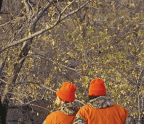SAME SPECIES, DIFFERENT STORIES

White-tailed deer exhibit something scientists refer to as “sexual dimorphism.” This simply means the sexes differ in secondary as well as primary sexual characteristics. The fact that males grow antlers and females normally do not is one good example of a sex difference in whitetails.
The whitetail sexes also differ in many other aspects of their physiology and behavior. Males, for example, have higher nutritional requirements for growth, take longer to attain their maximum body size, and don’t normally live as long, as compared to females. As with other ungulates (elk, moose, red deer, etc.), the adult whitetail sexes live separately except during the breeding season. This social and spacial separation is referred to as “sexual segregation” or “niche separation” of the sexes. As a result, adult male and female whitetails exhibit pronounced differences in their seasonal food and shelter requirements, as well as their social habits.
Healthy male whitetails also are considerably larger than females of the same age, a difference that widens with age.
Many studies have documented the effects of poor nutrition on whitetail body growth. Understandably, serious nutritional shortage results in smaller than normal deer. However, few researchers have specifically addressed the question of sex differences in body weight relative to diet changes or other factors
Theoretically, as the male’s quality of life declines, sex differences in body weight should diminish, because males respond more sensitively in terms of retarded body growth. If so, then narrowing of sex differences in body weight, by age class, should signal the need to alter deer habitat and/or herd management strategies.
RESOURCE PARTITIONING
While researching Lower Michigan’s enclosed George Reserve deer herd, Dale McCullough and his coworkers from the University of Michigan found that the whitetail sexes use space and habitat differently during the non-breeding season. Also, because of differences in diets and diet
You’re reading a preview, subscribe to read more.
Start your free 30 days





